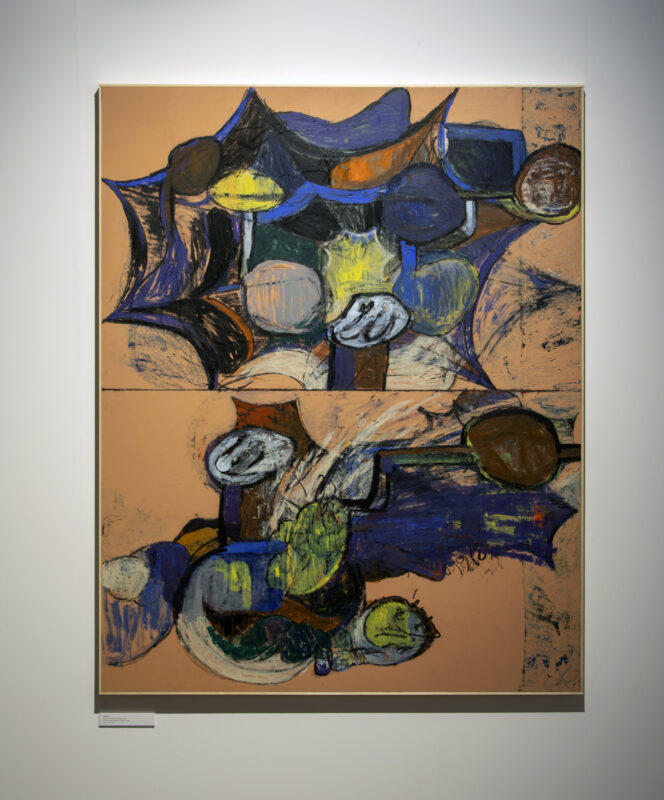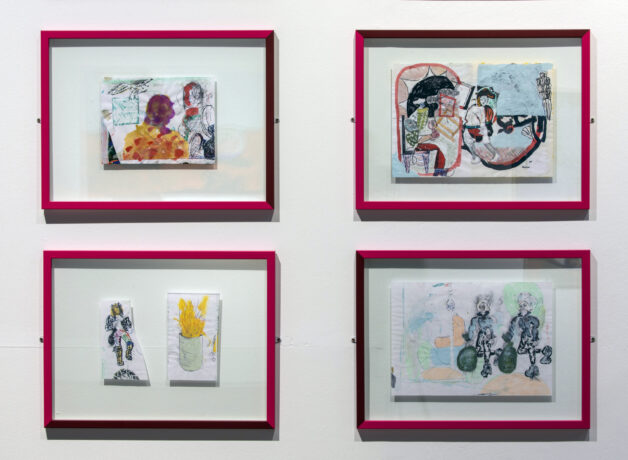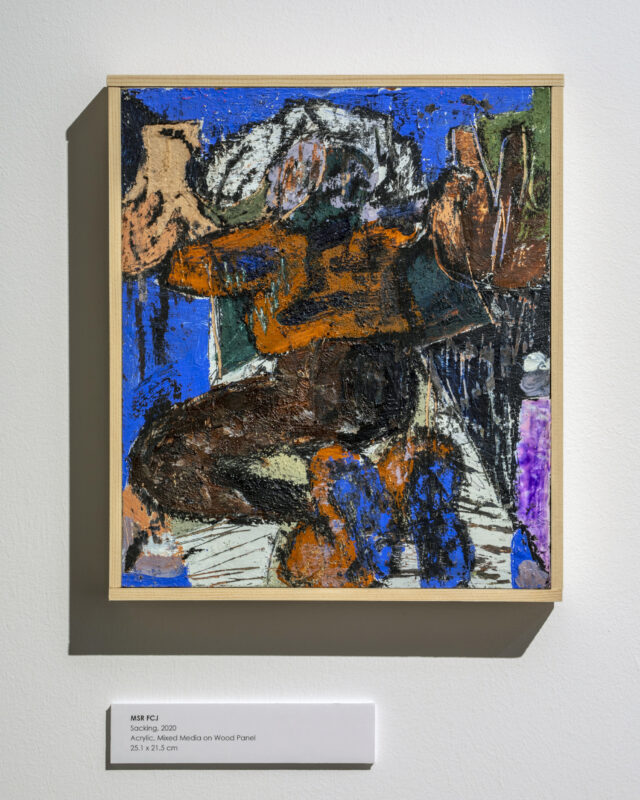MSR FCJ’s exhibition, Bubbling Pitch, is one of three that simultaneously reopened our main gallery, and which now have been transported online during the second lockdown. Curator Bren O’Callaghan spoke to them about their works.
Bren O’Callaghan: When did you first begin working together collaboratively – not simply exhibiting together – but creating joint-authored works?
MSR FCJ: From the beginning we would draw together, like playing games. This is how we got to know each other, reacting to one and others movements on the page. Often words initiate projects. The first ‘official’ collaborative work we put out together was a series of drawings fuelled by the meanings of extinct words. There were once single words that meant obscure things that lost their use somewhere along the way. Things like, ‘to throw one’s shoes out the window’ or ‘to smell of pee’ etc. The series of drawings became the zine ‘Tables’, which was published by Cafe Royal Books in 2012.
BOC: What is the result or qualities of your shared practice that you feel would not be present were you making solo work?
MSR FCJ: The work we make together is something of its own. It’s like digging a hole. We are both searching for our own things but what we find is something of a surprise. Something neither of us knew would be uncovered. There’s a level of trust and compromise, it’s a constant battle.

MSR FCJ, Poke My Thigh Or Padding, 2020, Acrylic, mixed media on wood panel. Photo credit: Lee Baxter
BOC: Fanzines, artist books and limited edition printed matter feels totally intrinsic to who you are and what you make. Not as an aside or standalone, but a foundation of your practice. What is the appeal for you?
MSR FCJ: We like to work with what we’ve got. To make a drawing you dont need a lot, it’s an intimate process. To make a zine you just need a photocopier. We are interested in working with all sorts of things. It’s all about making something out of nothing.
Right now we are mostly making paintings. It is like an ear and we are flies diving in over and over. We are always looking for new ways to transform our work. We started making paintings because we wanted to see our drawings on a larger scale. Using what we have and playing as we go. Painting is a whole new deep dive with a looming belly flop but that is part of the appeal.
BOC: When did you first begin creating what you might now term artwork, and what were your early influences?
MSR FCJ: As introverts it’s a handy outlet. Being alone with your thoughts is nice. The drive is personal, it’s ours and mostly only for our own satisfaction. It’s more like a personal clarification.
BOC: Who or what are your inspirations?
MSR FCJ: Inspiration is a tricky word, it’s so personal. It comes from lots of places if you let it. Gems hidden in the ground. In fact it is always flowing. Mood is inspiration. A mood can affect a person’s whole being. It can haunt you or linger like a dream. A ceiling fan is a mood. Constantly spinning but always in one spot. It’s so still and smoky. That is a big mood for us.

MSR FCJ, Bubbling Pitch drawings. Photo credit: Lee Baxter
There’s just that something-something about certain forms, accumulated heaps moulded by time. It’’s really everywhere and goes unnoticed. Rubbish and dirt is so interesting, it gathers and piles up and melds together like sculptures, piles of things, heaps and mounds. It’s partly abstract but also figurative and full of narrative, degraded stories. Like our paintings. Not to say we encourage littering or waste – save the planet, use bins, recycle and reduce waste – just visually it’s all about that mood. Lived faces. Cardboard hats. Those rare types of worked hands that bulge and bend.
BOC: What were the origins of the Bubbling Pitch exhibition? I understand it was loosely and indirectly spawned from a month long residency at Hospitalfield House in Scotland during August 2019.
MSR FCJ: We went to Hospitalfield House with the intention of making a series of new experimental drawings to inform a new set of paintings and to publish in a book. Initially we sought out visual triggers for a feeling or mood that was personal to the experience. We were taken by the overlooked, from the hidden, unnoticed or unexpected details of the unique residency setting. We translated these findings literally or abstractly into the works in an almost reimagining of the location. We attempted to let the mood and the place overcome us. Which it did. At first we became interested in the degrading paintings hung on the walls and how they were disappearing. Then we became interested in how the whole place was disappearing like mammoths sinking in a tar pit.
Through digital edit and risograph printing techniques, we transformed colour and composition as the drawings took a new form in an experimental publication we made with french publishers Editions FP&CF. This book then acted as a sort of guide to inspire the series of large paintings. We wanted to see how all the different mediums we work in could influence one and other.
BOC: What did you gain from this experience?
MSR FCJ: The experience confirmed for us that everyone and everything is covered in slime. Some get wiped and some don’t. Some get slid all over the place and others just sink in the pitch. But regardless we gained something that will accompany us both forever.
BOC: Talk us through the Bubbling Pitch exhibition, the drawings and the paintings…

MSR FCJ, Sacking, 2020, Acrylic, mixed media on wood panel. Photo credit: Lee Baxter
MSR FCJ: For this work we became very interested in things that don’t last but mutate and degrade. The mood of paintings change as pigments dissolve and figures become enveloped in darkness. All our work starts with drawing and Bubbling Pitch began this way. We decided that we would experiment as much as possible with the drawings and just allow things to happen in a natural way by not being too precious, dismantling and erasing until the ephemeral drawings had mutated and become their own unique fragments. Not being afraid to destroy what was before.
Then we used the drawings to make a book. Again we took an experimental approach. Cutting the drawings, zooming in on them and finally printing the pages at random in layers of risograph inks so each book would tell its own unique narrative. With this guide the paintings began to reveal themselves. The themes from the drawings and book filled out the paintings.
BOC: What would you like a viewer to know, if you could whisper into their ears as they walked around the exhibition?
MSR FCJ: Nothing. We try not to get lost thinking about anyone seeing the work. We think it’s better that the viewer has their own ideas about it. It’s way more fun for both sides that way.
BOC: When you attend exhibitions by others, what makes you a) happy to see, b) sad to see and c) angry to see?
MSR FCJ: It makes us happy to see art that is doing its own thing. Sad at gimmicks or on the nose trends. Anger at art that is hanging onto someone else’s coat tails.
BOC: Part of the work was created before lockdown, and part during. How did lockdown affect the completion, if at all?
MSR FCJ: This pandemic carries a heavy weight and we are all feeling it effects in some way or another. We finished Bubbling Pitch just before it all happened. But we kind of work as if in lockdown anyway. During the lockdown we’ve been pushing similar themes of ephemeral mutating works and also what paintings can be on less structured surfaces. Working on leftovers and scraps this new series of smaller works, titled ‘Rag Paintings’ push an even freer approach to what our work can be. This project continues throughout this strange time.